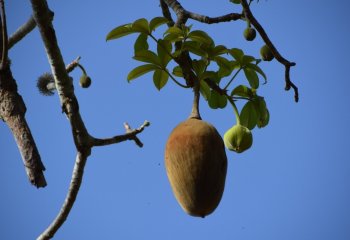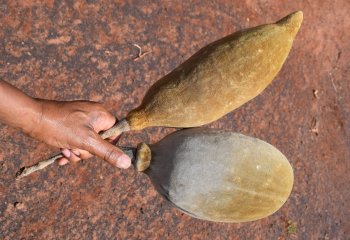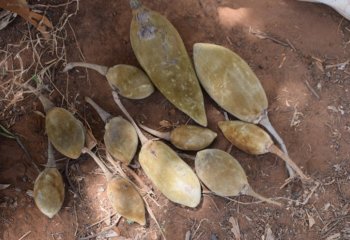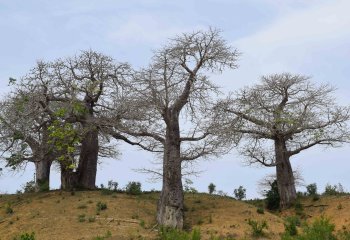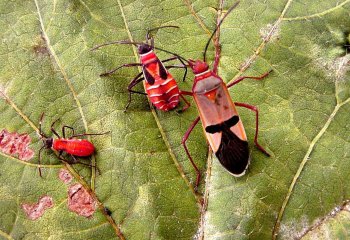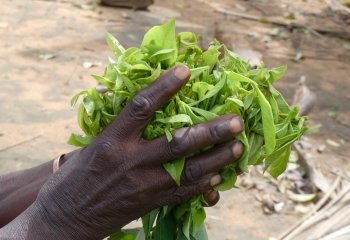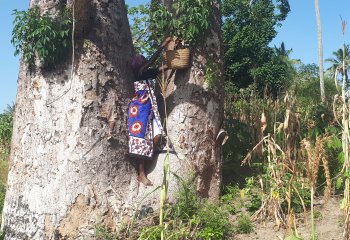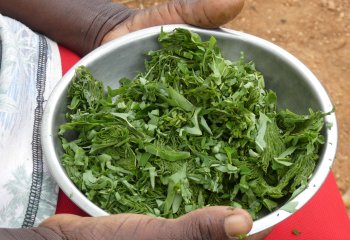Geographical Distribution in Africa
Baobab is indigenous in most tropical African countries. Baobab has been introduced in many other countries in the tropics and sub-tropics of the world.
Read more
Angola: Mbondo, Mukua (Kimbundu), Imbondeiro (Portuguese) (Bossard, 1996); Kibaba (Kikongo) (Göhre et al., 2016).
Benin: Sonnan (Bariba), Kadara (Kotokoli), Fonla (Boko), Butuobu,Tituokari (Gourmantché), Gatongaboi (Anii), Kôô (Dendi), Kutunga (Zerman), Kpèborè (Waama), Mutorumu, Titookanti, Yètookpèrè (Otammari), Zinzoun (Cotafon), Kpassa (Fon, Mahi, Aïzo), Otché (Tchabè, Idatcha, Ifè, Holly (Achigan et al., 2010); Donwo (Bariba); Boboli (Peuhl), Kpassagoto (Fon) (Adjanohoun et at.,1989).
Burkina Faso: Poo-Qô (Bissa) (Sita, 1978); Kôon (Sanan) Zerbo et al., 2011); Tohega (Moore) (Belem et al.,2007); Trega, Twega, Toayga (More), Ngigne (Senufo) (Sidibe & Williams., 2002).
Cameroon: Boko; Boki (Foufouldé) (Ngene, 2015)
Chad: Hamar, Hamaraya (Sidibe & Williams, 2002)
Cote d'Ivoire: Fromdo (Baule), Ngigne (Senufo) (Sidibe & Williams, 2002), Sirra (Dioula) (Ambé, 2001); Bu ba (Dioula), Boki (Malinké), Frondo (Baoulé), Ngigué (Sénoufo), Zizon (Fon), Toéga (Mossi), Baobab (French) (Aké-Assi, 1992).
DRC: Nkondo (Kongo); Pain de singe (French) (Latham and Mbuta., 2006)
Egypt: Habhab (Sidibe & Williams., 2002)
Eritrea: Tebeldi (Arabic), Asa (Kunama), Himeret (Tigre), Dim (Bilen), Dira (Bilen), Dari (Nara), Duma (Tigrigna) (Bein et al., 1996)
Ethiopia: Bamba (Amargna), Ba’obaab, Humaar (Oromugna), Yag (Somalgna), Dima (Guragigna), Hermer banba, Kommer, Momret (Tigrigna) (Tesemma et al., 2007); Hemmer, Dumma (Tigre), Bamba (Amhara) (Sidibe & Williams, 2002).
Ghana: Tùá (Dagomba) (Blench & Dendo, 2006); Odadie (Twi, in the South), Tua (Nankani, In the North) (National Academies of Sciences, 2006).
Guinea Bissau: Sito, Sira (Mandinka) (Orwa et al., 2009); Láté, Átè (Balanta), Buàs (Biafada), Uáto, Uvato (Bijagó), Cabaceira, Cabacera, Calabacera, (Guinean Creole), Baobab, Pain De Singe (Fruit) (French), Bóè (Fula), Bedom-Hal, Burungule-Burúnque (Mancanha), Citô (Mandinga), Bebáque, Bedom-Hal, Brungal (Manjaco), M'béke (Nalu), Burungule (Pepel), Cabaceira, Calabaceira, Imbondeiro (Portugese), Kiri (Sosso) (Catarino et al., 2016).
Guinea: Séda, Sira (Malinké), Boki (Poular, Malinke), Kiri (Soussou), Bohe (Foula du Fouta-Djallon) (Carrière, 1994).
Kenya: Muyu (Bajun), Jah (Boni), Muyu (Chonyi), Muuyu (Digo), Musemba (Embu), Muuyu, Mauyu {Fruit}(Giriama), Muamba, Mwaamba, Namba {Fruit}(Kamba), Olmesera (Masai), Mubuyu (Malakote), Muramba (Mbeere), Muiramba, Muramba (Meru), Yak (Orma), Lamai (Samburu), Yak (Sanya), Yak, Yaaq (Somali), Mbuyu, Muuyu (Swahili), Mlamba (Taita), Muguna Kiriindi (meaning-that which helps the masses), Muramba (Tharaka) (Maundu & Tengnas, 2005)
Madagascar: Reniala (Malagasy), Bozo (Sakalava dialect) (National Academies of Sciences, 2006); Baobaba, Baovola, Bozobe, Boy, Boringy, Mboio, Mboy, Rainiala, Reniala, Ringy, Sefo, Vanoa, Vontana (Malagasy) (Porcher Michel et al. 1995). Note: Some of the names may refer to other species of baobab.
Malawi: Bu ba (Dioula), Boki (Malinké), Frondo (Baoulé), Ngigué (Sénoufo), Zizon (Fon), Toéga (Mossi) (Aké-Assi, 1992); Mlonje (Yao), Mnambe, Mlambe (Chichewa), Mbuye (Nkonde) (Sidibe & Williams, 2002).
Mali: Sira, Nsira (Bambara), Zige (Minyanka), Zenge (Senoufo), 'Iya, 'Ile (Bwa), Pii (Bobo-Fing), Oro (Dogon) (Malgras, D., 1992); Idal (Sidiyenne, E. A., 1996); Oro (Dogon) Konian, Ko (Sonrai), Konian (Dierma), Babbe, boki, Olohi (Peulh), Sira, Sito (Madinke), Ngigne (Senufo) (Sidibe, M., & Williams, J. T., 2002).
Mauritania: Teidoum (Arabic), Gokki (Pulaar) (Tall, 1994).
Mauritius: Ros Mapon, (Creole), Anai Pouliya, Koye (Tamoul) (Daruty, 2018).
Mozambique: Mulambe, Malambe, Ximuwa, Ximuhu, Ximuvo (Changana) (Ribeiro, A., 2010)
Namibia: Mubuyu (Lozi) (Chinsembu & Hedimbi 2010).
Niger: Kuka (Hausa), Koo Mya (Zarma), Bokki (Peuhl), Taedrumpt (Tamacheck), Bulu Kuwa (Beriberi) (Adjanohoun, 1988).
Nigeria: Igi ose (Yoruba), Boki, Bokchi (Fula) (Orwa et al., 2009); Ose (Yoruba), Igi-Ose, Kuka (Hausa) (Ainslie, 1937); Kulambali, Gorakh-imli (Green institute, 2018); Kuka, Kouka (Hausa), Boki, Bokki (Fulani) (Sidibe & Williams, 2002).
Rwanda: Igiti cya bawoba (Kinyarwanda)
Senegal: Baak (Seereer), Bokki (Pulaar), Kommer, Hermer Banba, Momret, Duma (Tigrigna), Bui, Buee, Goui, Gui, Gwi (Wolof) (Orwa et al., 2009); Boki (Peul, Tocolor), Boi (Fouladou), Gui (Pour L'arbre), Lalo (Pour La Feuille) (Wolof), Sira, Sito (Bambara), Boy, Boiö, Boki (Peuhl) (Pordié & Magaud, M, 2001); Bubak (Diola) (Le Grand, & Wondergem., 1987); Ibak, Bak (Niominka), Sito (Socé) (Kerharo & Adam, 1964); Boubakakou (Dirla fogny), Boui (Wolof) (Sidibe & Williams, 2002).
Somalia: Yak (Somali) (Orwa et al., 2009)
South Africa: Mowana (Tswana), IsiMuku, Isimuhu, UmShimulu (Zulu) (Orwa et al., 2009); Ximuwu (Tsonga), Muvhuyu (Venda) (Andrew Hankey., 2004); Motsoo (Pedi) (Mongalo, & Makhafola., 2018); Shimuwu (Tsonga), Muvuhuyu (Tswana), Mayuy, Muuyu, Tsongoro (Seeds) (Shona) (National Academies of Sciences, 2006); Kremetart, Kremetartboom, Mubuyu, Muyu, Mbuyu, Mkulukumba, Mlambe (Afrikaans) (Sidibe & Williams, 2002); Umkomo (Ndebele) (National Academies of Sciences, 2006)
Sudan: Tabaldi (Gongoleis) (El-Kamali, 2009); Humeira (National Academies of Sciences., 2006); Dungwol (Dinka); Gunguleiz, Tebeldi, Humr, Homeira, Dungwol (Sidibe & Williams, 2002)
Tanzania: Mesera (Arusha), Mpela (Gogo), Dakaumo (Goro), Mkondo (Hehe), Gendaryandi (Iraqw), Mpela (Lugu), Olmesera (Masai), Muwiye (Mbug), Mramba (Pare), Mwiwi (Rangi), Gele (Sand), Mkondo (Sangu), Mwanda, Mwandu, Ngwandu (Suku), Mbuyu (Swah) (Mbuya et al, 1994); Nonji (Kingindo) (Haerdi, F., 1964); Moandu (Sukuma) (Kokwaro, 1993).
Togo: Todi (Nawdem), Tokala, Tuéleg, Kankanssio (Moba) (Adjanohoun, E et al., 1986)
Zambia: Mubuyu (Bemba), Mubuyu, Muyu (Lozi), Mbuyu, Mkulukumba, Mlambe (Nyanja) (Orwa et al., 2009)
Zimbabwe: Mbuyu, Muuyu (Shona), Umkhomo (Ndebele) (Hyde, M.A.,2021)
Introduction
Adansonia digitata, commonly known as the African Baobab, is a highly adaptable and drought-resistant fruit tree found in the arid and semi-arid regions of Sub-Saharan Africa. It is the sole species of the Adansonia genus in tropical Africa, distinguishing it from the other eight species found in Australia, Madagascar, and various islands in the South Pacific and Indian Ocean. Despite being a softwood tree, the African Baobab stands out as one of the longest-living trees, with a lifespan of up to 3,000 years. It possesses exceptional traits that enable it to thrive in dry climates, including an extensive root system, high water retention capacity, and early leaf shedding. Its smooth bark provides excellent resistance to drought and fires.
Within African communities, the Baobab tree and its products hold varying significance for sustenance and income generation. The baobab leaves, which are highly nutritious and rich in essential nutrients such as calcium, potassium, and vitamin C, are a popular vegetable in local communities throughout Africa. In the savannahs south of the Sahara, baobab leaves are widely consumed, making them one of the most common food sources between Senegal and Lake Chad. It is worth noting that although baobab trees are found in Eastern and Southern Africa, the leaves are rarely consumed in these regions.
Baobab leaves are harvested fresh and cooked as a potherb in some areas, while in others, they are dried and crushed for later use. These leaves have a unique taste that is slightly sour, tangy, and sweet, with hints of nuttiness or earthiness. When cooked, their flavour becomes mild and reminiscent of spinach. They have a slightly tough and fibrous texture, and the mucilage released during cooking gives them a slightly slippery and slimy consistency. Baobab leaves are commonly added to soups, stews, sauces, and relishes, enhancing the flavour and nutritional value of the dishes while also thickening them. They are frequently served as a side dish, similar to spinach, and poured over various staple foods such as yam, cassava, maize, millet, sorghum, etc., to complete the main meal.
Baobab leaves have also been found to possess various medicinal properties. In traditional African communities, powdered baobab leaves are commonly used by traditional healers to treat ailments such as asthma, fever, malaria, smallpox, and diarrhoea. Studies have demonstrated their potential as anti-inflammatory, antipyretic, anti-diarrheal, and antiplasmodial agents. Furthermore, these leaves exhibit remarkable antioxidant properties, further adding to their therapeutic potential. Further research is necessary to determine the safety and effectiveness of using baobab leaves for medicinal purposes in humans.
During the rainy season, baobab leaves serve as a vital source of sustenance for domestic livestock and wild animals, including elephants and impalas, especially when grazing lands are depleted and new growth has yet to emerge.Furthermore, the baobab leaves are a significant source of food for animals, and the tree itself provides habitats for many wild animals, contributing to the preservation of biodiversity in the region. Additionally, the tree provides other ecosystem services such as carbon sequestration, soil enrichment, air and water quality improvement, and biodiversity conservation (Hankey, 2004).
(National Academies of Sciences, 2006, Hankey, 2004, Alao et al., 2016, Maundu & Tengnas, 2005).
General Information
Species account
Adansonia digitata is a succulent, deciduous tree that can grow up to around 20 meters tall, often with a very sparse crown, especially in the drier parts of its range. The swollen, urn-shaped bole eventually becomes very wide, often exceeding the diameter of the crown, and can be up to 10 meters across. The stem is covered with a bark layer, which may be 50-100 mm thick (Fern, 2021). Bark; is greyish brown and usually smooth but can often be variously folded and seamed from years of growth. Leaves; are hand-sized and divided into 5-7 finger-like leaflets. Flowers; The flowers are large, white, or yellow, with prominent stamen protruding over crinkled petals and sweetly scented. They emerge in the late afternoon from large round buds on long drooping stalks in early summer. Large, egg-shaped Baobab fruits develop at the early stages of growth. Fruits; are green in color, turning brownish-grey as the fruit ripens. Unlike the flowers, the fruits hang pendulously off the branches on long pedicels (Hankey, 2004).
|
© J. Kioko
|
© P. Maundu, 2022 |
|
© J. Kioko |
The mature fruit consists of a hard, woody outer shell covered with yellowish-brown hairs that feel velvety. They exhibit different forms; small and big, tapered and rounded, and even the fruit skin hair hue. The fruit contains red-brown and coarse fiber that crisscross the fruits and holds creamy powdery fruit pulp. The fine pulp covers large kidney-shaped seeds. Roots; Baobab tree produces an extensive network of lateral roots that end in tubers. The seedlings produce prominent taproot, which is quickly replaced by laterals. Roots of mature trees rarely extend beyond 2 meters and are relatively shallow, which is one reason why old trees frequently fall over.
|
Ⓒ P. Maundu, 2021 |
Ⓒ Maundu, 2022 |
Ecological information
Annual rainfall: Baobabs are most common, where mean annual rainfall is 200-1,200 mm. However, they are also found in locations with as little as 90 mm or as much as 2,000 mm of mean annual rainfall.
Altitude: The Baobab is usually found in elevations ranging from 0-1,300 m above sea level.
Soil type: The tree grows on a wide range of soils; however, A digitata shows a preference for acidic, well-drained soils (pH <6.5), preferably with sandy topsoil's overlaying loamy substrates (Orwa et al., 2009).
Temperature: Baobab thrives where the mean annual temperature is 20-30°C. It succumbs to frost. Reportedly, germination is achieved only when soil temperature exceeds 28°C (National Research Council, 2006).
Ⓒ J. Muia, 2022
Agronomic aspects
Natural propagation
The Baobab tree's natural regeneration process is impeded by multiple factors, including browsing animals, prolonged drought, and uncontrolled bushfires. Furthermore, the seeds exhibit low germination rates, with the process naturally taking several years to initiate, often requiring fire to break dormancy. In addition to this, the digestive tract of mammals such as elephants and baboons can facilitate seed dormancy breakage, thereby contributing to the Baobab's natural propagation (Maundu & Tengnas, 2005).
Growing Baobabs from seeds
The propagation of African baobabs is predominantly achieved through seed germination, which requires specific conditions to be effective. Mechanical scarification is a crucial step for successful germination, as the seeds have a hard and thick seed coat that hinders water absorption, resulting in a prolonged emergence period of up to several year.
According to Maundu and Bo Tengnas (2005), seed germination of Baobab trees can be induced by fire, as the heat softens the seed coat, thus allowing water to penetrate the seed. Other methods of scarification include soaking the seeds in hot water, cutting or sanding the seed coat, or exposing them to sulfuric acid. These methods have been found to increase germination rates and shorten the time required for seedling emergence. It is important to note that seedling growth can be slow, and seedlings require a well-draining substrate to thrive. Once the seedlings have developed into saplings, they can be transplanted into their permanent locations. Air layering, grafting, and cuttings also been successfully utilized and are considered less costly but less effective. (Sidibe & Williams, 2002; Arum, 1989).
Seed collection
To collect Baobab seeds, one can either retrieve them from fruits that have fallen off the tree or use poles and sticks to dislodge fruits from the tree's canopy. Once collected, the seeds should be air-dried and stored in clean, dry, and labelled containers in cool, dry places to prevent damage from moisture, insects, fungal infections, rats, and mice. However, collecting seeds from fallen fruits may not be effective as the seeds may have lost viability or become infected. For shorter trees, seeds can be harvested from the ground or by climbing up a ladder. It is important to note that the collection method can affect the seed's quality, and careful selection of seeds is necessary for successful propagation (Sidibe & Williams, 2002; Arum, 1989).
Planting
Seed pre-treatment is a crucial process that can significantly impact the germination rate of baobab seeds. Scarification with concentrated sulphuric acid for 6-12 hours is a common pre-treatment method that has been shown to result in a germination rate of over 90%. However, in rural areas, manual scarification or boiling seeds in water for 15 minutes can be used as an alternative.
Direct seeding into the field has not proven to be very successful, so it is recommended to raise seedlings in a nursery potting mixture of topsoil, sand, and compost. (3 parts topsoil, 1 part sand, and 1 part compost); they can be sown in beds, pots, or polybags. The germination of baobab seeds can be sporadic and take up to a month. Once seedlings emerge, they should be shaded for 8 days, given half shade for 4-7 days, and then exposed to full light after 12-15 days.
Baobab seedlings should be transplanted at the beginning of the rainy season when they are at least 3-4 months old and have reached a height of 40-50cm. Seeds should be sown 1 to 2 inches deep, and soil temperature should be maintained at a minimum of 15 degrees Celsius. Soil should be kept evenly moist but not wet. Planting should be done at a spacing of 10m x 10m. After transplanting, it is crucial to protect the baobab trees from game, livestock, and fire until they are well established (Sidibe & Williams, 2002, Arum, 1989).
Tree management
The tree should not be planted near houses. Lateral roots may reach over 100m. Pollarding can increase leaf production and prevent toppling of hollow trees, but may reduce fruit production for a few years.
Ⓒ J. Muia, 2023
Pest and disease management
Baobab trees have a natural resistance to pests and diseases and are able to withstand environmental stressors due to their thick bark, water storage capabilities, and adaptability. While baobab trees are generally hardy and resistant to pests and diseases, some pests, fungal and viral diseases can affect the tree, and several insect pests that can attack the wood, fruit, and young shoots.
Information on pests
The Baobab tree supports a diverse ecosystem with wide range of insects that do not significantly affect its productivity. While the Baobab tree itself may remain resilient, nearby cultivated crops or native plants could become susceptible to infestation or damage by these pests. It is crucial to monitor and manage pest populations to mitigate potential negative impacts on the surrounding flora. Some of the common Pest that inhabit pests include:
Cotton Bollworm (Helicoverpa armigera)
| The cotton bollworm is a destructive pest that affects a wide range of crops, including cotton. The adult moth has a wingspan of around 3-4 cm and has mottled brown or gray wings. The larvae are caterpillars that vary in colour from green to brown or pinkish and have distinct longitudinal stripes along their bodies. |
What to do:
- Encourage natural predators of the cotton bollworm, such as parasitic wasps, ladybugs, and birds, by providing habitat and avoiding the use of broad-spectrum insecticides.
- Regularly monitor the trees for signs of infestation and remove any affected fruits or larvae by hand.
- Proper sanitation practices, such as removing fallen fruits and plant debris, can also help reduce the population.
- Natural insecticides derived from plants, such as neem spray or a garlic-chilli-onion-repellent and Bt, can be used as organic alternatives to control cotton bollworms.
Cotton Strainer Bugs (Dysdercus spp.)
|
Cotton strainer bugs are true bugs that are primarily known for their damage to cotton crops. Stainer bugs are between 14 and 24 mm long. They are bright red, yellow or light grey with an orange tinge depending on the species, and with black bands. Stainer bugs are late season pests. They appear when the bolls are ripening. Female lays whitish yellow eggs in moist soil or in crevices in the ground. They hatch to produce reddish-orange nymphs. Initially the nymphs are wingless, but wings develop gradually as the nymphs grow. The nymphs are found together in the area where the eggs have been laid and later disperse to look for food. Both nymphs and adults feed on the bolls, but adults cause the most serious damage. They pierce through the boll and suck the seeds reducing germination capability and the quality of the seed oil and the cake. Furthermore, they cause severe indirect damage by transmission of a fungus (Nematospora sp.), which leads to internal boll rot and stain of the lint with typical yellow colour, hence the name 'cotton stainers'. |
Ⓒ A.M. Varela, ICIPE |
|
What to do:
|
|
Information on diseases
Sooty mould (Antennulariella sp.)
This disease manifests itself through the appearance of orange-brown spots primarily on the undersides of branches. As the infection progresses, these spots darken and merge to form larger patches, giving the affected areas a blackened appearance.
Reports of sooty mould affecting baobabs have emerged from various regions in southern Africa, including Malawi, South Africa, Zambia, and Zimbabwe. The presence of black mould on the stems and branches of African baobabs has been closely associated with a decline in the health of these remarkable trees. Fortunately, sooty mould fungi do not penetrate beyond the outer layer of the baobab's bark, known as the epidermis. While in severe cases, the extensive growth of the fungi on leaves can hinder the plant's photosynthetic ability, it does not directly interact with the plant cells to elicit a physiological response (Chomnunti et al., 2014, Hughes, 1976, Cruywagen et al, 2015).
What to do:
- Regular pruning helps remove heavily infested branches or parts of the tree where honeydew and sooty moulds are prevalent. Pruning also promotes better air circulation and sunlight penetration, creating an unfavourable environment for the growth of sooty moulds
- Maintain proper sanitation practices in the vicinity of the Baobab. This significantly reduce the chances of fungal spores being transported to healthy trees. This entails clearing away fallen leaves, debris, and other organic matter that may serve as potential breeding grounds for the fungi.
- Furthermore, promoting optimal tree health through appropriate watering, adequate nutrition, and preventing any physical damage to the baobabs can enhance their resilience against sooty mould infections.
Harvesting, post-harvesting practices and value addition
Harvesting baobab leaves
Ⓒ P. Maundu, 2014
The baobab tree displays an impressive burst of foliage at the onset of the rainy season, remaining green throughout the rainy-to-harvest season. In healthy trees, the colour of the leaves is a strong green, in some even dark green. Freshly emerging leaves are light green, but darken over time.
Fresh young baobab leaves are harvested, with people often climbing the trees to pluck every tender leaf within reach. In some instances, ladders or steps are cut into the tree's side to allow easy access to the upper parts. While some trees are kept denuded throughout their life, others are pollarded, with their top branches cut back to the trunk, inducing dense growth of new shoots. Towards the end of the rainy season, the leaves are harvested and sun-dried for domestic use and marketing during the dry seasons. The drying process involves leaving the leaves whole or pounding and sieving them into fine powder (National Academies of Sciences, 2006, Sidibe & Williams, 2002).
|
Ⓒ J. Muia, 2022 |
Ⓒ P. Maundu, 2022 |
Post-harvest practices
Different communities employ distinct methods of post-harvest handling. In Zimbabwe, Baobab leaves are harvested and sundried before being ground into a powdered form for utilization as a soup thickener. In Mali, the leaves are powdered and used in the production of a local soup known as Lalo, which is sold in West Africa. In northern Nigeria, the leaves are utilized in the preparation of Miyan Kuka, a soup commonly consumed by the Hausa tribe (Asogwa et al., 2021).
Effective post-harvest handling plays a critical role in preserving the quality of Baobab leaves. It is essential to store the leaves in a cool, dry, and well-ventilated environment to prevent moisture absorption and subsequent spoilage.
Value addition and market value
Baobab leaves are used in various ways such as in soups, stews, sauces, and as a vegetable. They can also be dried and ground into a powder that can be used as a food supplement or added to smoothies.
The market value of Baobab leaves is increasing due to the growing demand for natural and organic products. In some African countries such as Senegal and Zimbabwe, baobab leaves are sold at local markets for up to $10 per kilogram. The leaves are also exported to other countries such as Europe and the United States where they are used in the production of herbal teas and supplements (Rashford, J, 2018).
Nutritional value and recipes
Baobab leaves are a nutritional powerhouse, containing high amounts of calcium, magnesium, phosphorus, potassium, vitamins A and C, beta-carotene, and folate. Calcium is essential for maintaining strong bones and teeth, while magnesium is important for nerve and muscle function, regulating blood pressure, and maintaining a healthy immune system. Phosphorus is necessary for energy production and bone health, and potassium is crucial for maintaining healthy blood pressure and heart function.
Vitamin A plays a crucial role in maintaining healthy vision, skin, and immune system function. Vitamin C is a powerful antioxidant that helps protect cells from damage, supports immune system function, and aids in collagen synthesis for healthy skin, tendons, and ligaments. Beta-carotene is converted to vitamin A in the body and is important for maintaining healthy skin and vision. Folate is a B vitamin that is essential for healthy foetal development during pregnancy and helps to produce red blood cells. In addition to these essential vitamins and minerals, baobab leaves also contain a relatively high amount of fibre which aids in digestion and can promote a feeling of fullness.
(National Academies of Sciences, 2006).
Table 1: Proximate nutritional composition of 100 g of Baobab leaves
|
Baobab. leaves. dried |
Baobab. leaves. fresh, raw |
Baobab. leaves. fresh. boiled* (as part of a recipe) |
Baobab. leaves. fresh. boiled* (without salt). Drained |
Recommended daily allowance (approx.) for adults |
|
|
Proximate composition and dietary energy |
|
|
|
|
|
|
Edible portion |
1 |
0.54 |
0.52 |
0.53 |
|
|
Energy (kJ) |
999 |
259 |
275 |
264 |
9623 |
|
Energy(kcal) |
241 |
62 |
66 |
64 |
2300 |
|
Water (g) |
7.5 |
76.7 |
75.2 |
76.2 |
2000-3000c |
|
Protein (g) |
13.7 |
3.9 |
4.2 |
4 |
50 |
|
Fat (g) |
2.3 |
0.4 |
0.4 |
0.4 |
<30 (male), <20 (female)b |
|
Carbohydrate |
19.8 |
5.4 |
5.7 |
5.5 |
225 -325g |
|
Fibre. Total dietary (g) |
42.9 |
10.8 |
11.5 |
11 |
30d |
|
Ash (g) |
13.8 |
2.8 |
3 |
2.9 |
|
|
Mineral composition |
|
|
|
|
|
|
Calcium (mg) |
1,240 |
313 |
333 |
304 |
800 |
|
Iron (mg) |
13.7 |
3.5 |
3.7 |
2.6 |
14 |
|
Magnesium (mg) |
206 |
52 |
55 |
32 |
300 |
|
Phosphorus (mg) |
336 |
85 |
90 |
78 |
800 |
|
Potassium (mg) |
1,490 |
376 |
400 |
192 |
4,700f |
|
Sodium (mg) |
166 |
42 |
44 |
32 |
<2300e |
|
Zinc (mg) |
3.56 |
0.9 |
0.95 |
0.69 |
15 |
|
Copper (mg) |
0.72 |
0.18 |
0.19 |
0.18 |
0.9 |
|
Bioactive compound composition |
|
|
|
|
|
|
Vit A RE (mcg) |
286 |
426 |
408 |
392 |
800 |
|
Vit A RAE (mcg) |
143 |
213 |
204 |
196 |
800 |
|
Retinol (mcg) |
0 |
0 |
0 |
0 |
1000 |
|
Beta carotene equiv (mcg) |
1,720 |
2,558 |
2,450 |
2,350 |
600 – 1500g |
|
Vit D (mcg) |
0 |
0 |
0 |
0 |
5 – 15* |
|
Vit E (mg) |
1.7 |
0.42 |
0.45 |
0.43 |
9 |
|
Thiamine (mg) |
0.1 |
0.03 |
0.03 |
0.02 |
1.4 |
|
Riboflavin (mg) |
0.15 |
0.04 |
0.04 |
0.03 |
1.6 |
|
Niacin (mg) |
0.7 |
0.7 |
0.5 |
18 |
|
|
Vit B6 (mg) |
1.5 |
0.4 |
0.39 |
0.27 |
1.3 |
|
Folate (mcg) |
[300] |
[97] |
[72] |
[49] |
400f |
|
Vit B12 (mcg) |
0 |
0 |
0 |
0 |
3 |
|
Vit C (mg) |
19 |
47 |
30 |
19 |
60 |
Source (Nutrient data): FAO/Government of Kenya. 2018. West African food composition table, https://www.fao.org/3/ca7779b/CA7779B.PDF
$ Draining the water several times leaches away water soluble nutrients significantly.
a Lewis, J. 2019. Codex nutrient reference values. Rome. FAO and WHO
b NHS (refers to saturated fat)
c https://www.hsph.harvard.edu/nutritionsource/water/
d British Heart Foundation
e FDA
f NIH
g Mayo Clinic
Complimentary recipes
1. Baobab and Cassava vegetable
Mijikenda in coast Kenya recipe
Ingredients for Baobab/ Mpea dish (serves 6 people)
- One handful of tender Baobab leaves (Tender leaves picked from young Baobab shoots)
- Three handfuls of pounded Mpea (Cassava leaves). Tender leaves from cassava shoots.
- Two medium-sized Coconuts (if the coconut is fleshy, as is the case during the rainy season, a coconut is enough.)
- ½ teaspoonful of salt
- 3 cups of water
Cooking procedure
- Sort Baobab and cassava leaves
- The Cassava leaves are pounded in a mortar before cooking to improve palatability.
- Boil pounded cassava leaves in a pot for 3-4 minutes on high heat
- Add Baobab leaves to the pot and boil for 3 minutes.
- Prepare the Coconut Milk by mixing 1/2 a cup of water and grated coconut flesh. The mixture is squeezed tightly in the hands or strained through a fine cloth to wring all liquid from the coconut flesh.
- Add the Coconut milk and salt to the boiling vegetable mixture and boil for another 2 minutes
2. Miyan Kuka (Baobab leaves soup)
Traditional Nigerian soup
Ingredients
- 500g meat with bone or meat alternatives (veal, lamb, beef, chicken or Tofu)
- 4 tbsp ground baobab leaves (22g)
- 1 onion
- 1 tomato
- 3 garlic cloves
- 2 bay leaves
- 1 tbsp of ground soumbala (also called dawadawa is a fermented seed condiment in West Africa)
- 1 tsp dried shrimps
- 3 cups of water
- 1 hot pepper
- Salt and black pepper to taste
- Oil
Cooking procedure
- Chop onions and garlic. Cut meat into pieces
- Add 2 tablespoon full of oil into a pot, and adjust heat to medium- high
- Add meat and onions to oil, and sauté for about 2-3 minutes until both meat turn brown. Add tomatoes, garlic bay leaves and 3 cups of water
- Scrape the bottom of the pan with a wooden spoon if any residue are stuck
- Take care to have the meat covered with water. Add about ¼ tsp of salt
- Partly cover stew and cook for about an hour. Add soumbala and dried shrimp. Cook for 20 more minutes. Meat should be tender
- Add baobab leaf powder, about 1 tbsp at a time and mix after each addition to incorporate the powder
- Let simmer for about 10 more minutes
Source:
3. Fried Baobab leaves
|
Ingredients (yields 4 servings)
|
Ⓒ J. Muia. 2022 |
|
Cooking procedure
Serve with preferred starch and stew |
Information on diseases
Sooty mould (Antennulariella sp.)
This disease manifests itself through the appearance of orange-brown spots primarily on the undersides of branches. As the infection progresses, these spots darken and merge to form larger patches, giving the affected areas a blackened appearance.
Reports of sooty mould affecting baobabs have emerged from various regions in southern Africa, including Malawi, South Africa, Zambia, and Zimbabwe. The presence of black mould on the stems and branches of African baobabs has been closely associated with a decline in the health of these remarkable trees. Fortunately, sooty mould fungi do not penetrate beyond the outer layer of the baobab's bark, known as the epidermis. While in severe cases, the extensive growth of the fungi on leaves can hinder the plant's photosynthetic ability, it does not directly interact with the plant cells to elicit a physiological response (Chomnunti et al., 2014, Hughes, 1976, Cruywagen et al, 2015).
What to do:
- Regular pruning helps remove heavily infested branches or parts of the tree where honeydew and sooty moulds are prevalent. Pruning also promotes better air circulation and sunlight penetration, creating an unfavourable environment for the growth of sooty moulds
- Maintain proper sanitation practices in the vicinity of the Baobab. This significantly reduce the chances of fungal spores being transported to healthy trees. This entails clearing away fallen leaves, debris, and other organic matter that may serve as potential breeding grounds for the fungi.
- Furthermore, promoting optimal tree health through appropriate watering, adequate nutrition, and preventing any physical damage to the baobabs can enhance their resilience against sooty mould infections.
References and information links
- Adansonia digitata L. in GBIF Secretariat (2021). GBIF Backbone Taxonomy. Checklist dataset https://doi.org/10.15468/39omei accessed via GBIF.org on 2021-11-28.
- Alao, J. S., Wakawa, L. D., & Ogori, A. F. (2016). Ecology, Economic Importance and Nutritional Potentials of Adansonia digitata (BAOBAB): A Prevalent Tree Species in Northern Nigeria. https://www.researchgate.net/publication/311735499_Ecological_requirements_economic_and_nutritional_potentials_of_adansonia_digitata_baobab_a_prevalent_tree_species_of_North_east_region_of_nigeria
- Andrew Hankey. (2004). Adansonia digitate. South African National biodiversity institute. http://pza.sanbi.org/adansonia-digitata
- Arum, G. (1989). Baobab: Adansonia Digitata. Kengo.
- Asogwa, I. S., Ibrahim, A. N., & Agbaka, J. I. (2021). African baobab: Its role in enhancing nutrition, health, and the environment. Trees, Forests and People, 3, 100043.
- Atuna, R., Achaglinkame, M., Amagloh, F., Dari, L., Osei-Kwarteng, M., Mahunu, G., Bakker, S., Djah, J., & Koomen, I. (2021). Catalogue of Selected Indigenous Vegetables in Ghana Report. doi: 10.13140/RG.2.2.16401.51044.
- Baobab facts and health benefits. (2019, June 5). Health Benefits | Health Benefits of Foods and Drinks. Retrieved October 1, 2022, from https://www.healthbenefitstimes.com/baobab/
- Bosch, C.H. & Sié, K. & Asafa, B.A., (2004). Adansonia digitata L. [Internet] Record from PROTA4U. Grubben, G.J.H. & Denton, O.A. (Editors). PROTA (Plant Resources of Tropical Africa / Ressources végétales de l’Afrique tropicale), Wageningen, Netherlands. <http://www.prota4u.org/search.asp>. Accessed 29 November 2021.
- Cruywagen, E. M., Crous, P. W., Roux, J., Slippers, B., & Wingfield, M. J. (2015). Fungi associated with black mould on baobab trees in southern Africa. Antonie van Leeuwenhoek, 108, 85-95.
- Fischer, S., Jäckering, L., & Kehlenbeck, K. (2020). The Baobab (Adansonia digitata L.) in southern Kenya–a study on status, distribution, use and importance in Taita–Taveta County. Environmental management, 66(3), 305-318.
- Hyde, M.A., Wursten, B.T., Ballings, P. & Coates Palgrave, M. (2021). Flora of Zimbabwe: Species information: Adansonia digitata. https://www.zimbabweflora.co.zw/speciesdata/species.php?species_id=139770 retrieved November 28 2021
- Lock, M., Grubben, G. J. H., & Denton, O. A. (2004). Plant Resources of Tropical Africa 2. Vegetables. In Kew Bulletin (Vol. 59, Issue 4). https://doi.org/10.2307/4110929
- LP Mbuya, H P Msanga, CK Ruffo, Ann Birnie ,Bo Tengnas, 1993. Useful trees and shrubs of Tanzania. Published by the regional soil conservation Unit (RSCU). Swedish international development authority(SIDA).
- Maundu P. and Bo Tengnas. (2005). Useful trees and shrubs for Kenya, World Agroforestry Centre. www.worldagroforestrycentre.org
- National Academies of Sciences, 2006. Lost Crops of Africa: Volume II: Vegetables. Washington, DC: The National Academies Press. https://doi.org/10.17226/11763.
- Orwa C, Mutua A, Kindt R, Jamnadass R, Simons A (2009) Agroforestree Database: a tree reference and selection guide. Version 4.0. http://www.worldagroforestry.org/af/treedb/. Accessed August 8 2014
- Patrick M. Maundu, Grace W. Ngugi, and Christine H.S. Kabuye, Traditional Food Plants of Kenya, Kenya Resource Centre for Indigenous Knowledge, National Museums of Kenya, Nairobi, Kenya, 1999, p. 106.
- Rashford, J. (2018). The use of baobab leaves (Adansonia digitata L.) for food in Africa: a review. Economic Botany, 72(4), 478-495.
- Sidibe, M., & Williams, J. T. (2002). Baobab, Adansonia digitata L (Vol. 4). Crops for the Future
- Tropical Plants Database, Ken Fern. tropical.theferns.info. 2021-11-28. https://tropical.theferns.info/viewtropical.php?id=Adansonia+digitata
Contacts information
The following can supply Baobab seeds:
- For more information on the Baobab tree contact Kenya resource centre for indigenous knowledge (KENRIK). https://cbd.or.ke/kenya-resource-centre-for-indigenous-knowledge-kenrik/
- Baobab Farm Ltd. PO Box 81995 Mombasa, KENYA
- Kenniex Ltd. PO Box 50982 Nairobi, KENYA
- Institute Sénégalais de Recherches Agricoles 76 Rue Mousse Diop BP 320 Dakar, SENEGAL


